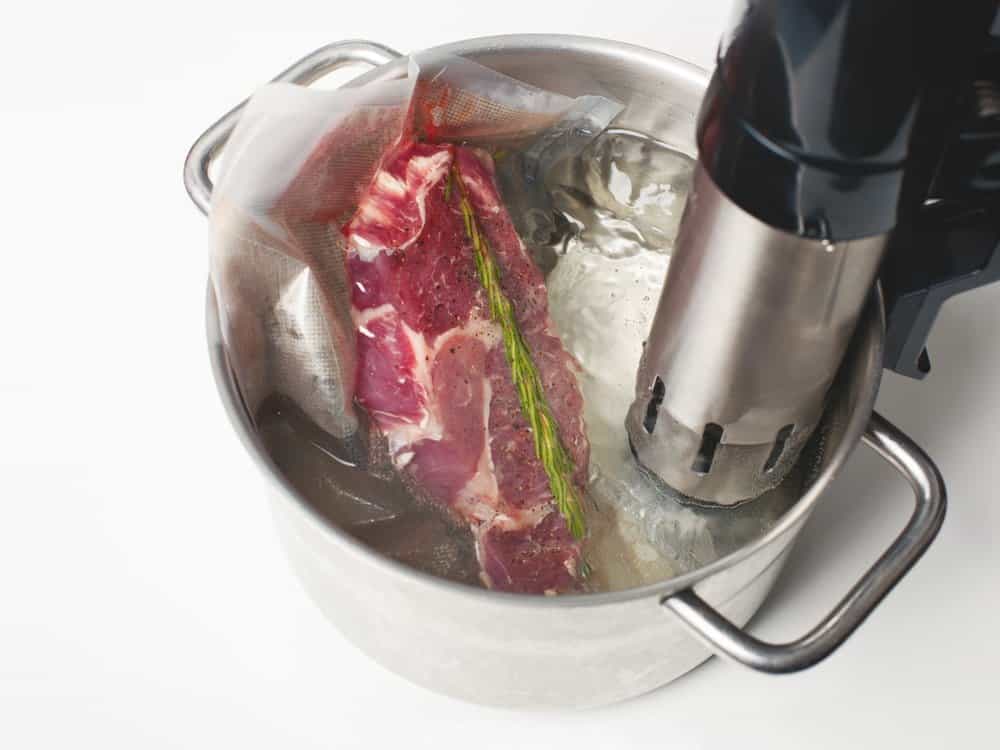What Is a Sous Vide Immersion Circulator?
A common misconception is that sous vide cooking is something that’s only done in fancy, high-end restaurants.
But thanks to the sous vide immersion circulator, it’s actually now possible to use this cooking process that guarantees consistent and perfect results every single time at home.
So what is a sous vide immersion circulator? First, let’s get a little technical and take a look at the mechanics of immersion circulators, so you can understand how they’re used for cooking.

What Is an Immersion Circulator, and How Does It Work?
A sous vide immersion circulator is an electrical device that’s placed partially submerged in a water bath to heat and circulate it, maintaining the water at a precise and consistent temperature throughout.
A standard immersion circulator is made up of these parts:
- Heating element that goes in the water to heat it up
- Circulator pump or motor to move the water around to keep it at a consistent temperature
- Thermometer to read the temperature of the water
- Control circuitry, which compares the temperature of the water to the temperature you set the device to heat to and then powers the heating element as needed to match your desired temperature (to learn about how much electricity immersion circulators use, click here)
- Interface for setting and viewing the temperature and timer (some immersion circulators now actually have an app for this!)
The key thing to remember about immersion circulators (and what makes them so amazing) is that they make sure that the water they’re immersed in is at an exact temperature all throughout the container.
This is why they’re used for sous vide cooking! Meat or vegetables are placed into a Ziploc or vacuum sealed bag (or even a canning jar), submerged in the water bath held by a separate container, and slowly cooked at the temperature of the water controlled by the sous vide immersion circulator.
Now that you understand how sous vide immersion circulators work, let’s get into the details of how to set one up and prepare a perfectly delicious and evenly cooked dish.
How Do You Set Up a Sous Vide Immersion Circulator for Cooking?

Let’s go through the steps of setting up a sous vide immersion circulator and how to use it for cooking.
- Choose a container to cook in that should also be the right size based on the amount and size of food you’re cooking. This can be a saucepan, dutch oven, stock pot, or plastic tub.
- Most sous vide cookers are clamped over the side of the pot or plastic container. However, the Joule is a different type that sits at the bottom of the pot and stands freely using a magnetic base. It’s a good idea to check the manual to see how yours should be positioned.
- Fill the pot or container with water to submerge the sous vide cooker. Most sous vide cookers have a fill line to help you see how much water to use, so be sure to look out for this.
- Make sure the immersion circulator is plugged in, and set it to the correct cooking temperature (this will vary greatly depending on what you’re cooking)
- Once the water has reached the desired temperature, take your bagged food and submerge it in the water (if you’re using a Ziploc bag, make sure you remove the air from the bag first). To make sure the bag stays submerged you can clip it to the side of the pot or you can use a weight to make the bag heavier.
- Now, all you have to do is wait! Once the timer runs out, remove the bag(s) from the pot and you’re ready to plate and enjoy your perfectly cooked meal.
Tip: when you’re done cooking, don’t throw away the leftover juices in the sous vide bag! Click here to see what you can do with these juices to elevate your dish, including how to make a sauce out of it.
As you can see, cooking with a sous vide immersion circulator is a pretty easy, mostly hands-free process. And, you get the best flavor and perfect temperature every single time!
Can a Sous Vide Immersion Circulator Sit on the Bottom of a Pot?
Maybe you don’t have a deep enough pot or container, and your sous vide cooker touches the bottom of your pot. Is this okay?
The answer is it depends. It depends on the brand of immersion circulator you have, so you should definitely check the user manual.
If you have the Joule Sous Vide, these have a magnetic base (in addition to a clamp) that holds to most pots, so these can certainly be touching the bottom of the pot.
Worst case scenario, you just have to get a deeper pot or container, which can come at a pretty reasonable price.
In Summary
When it comes to sous vide machines, the sous vide immersion circulator is unique in that it’s a standalone device that both heats and circulates water for cooking.
It offers absolute precision in cooking and has the added convenience of being very easy to use at home!
My 5 favorite sous vide immersion circulators:







